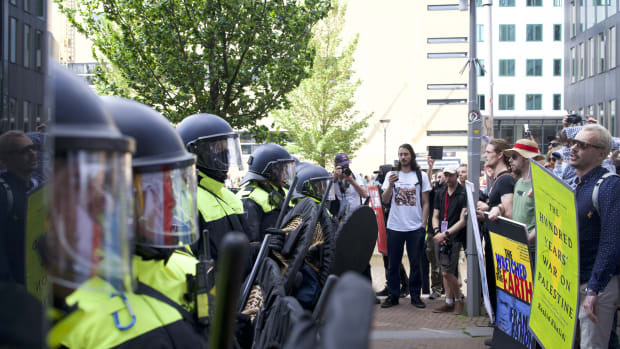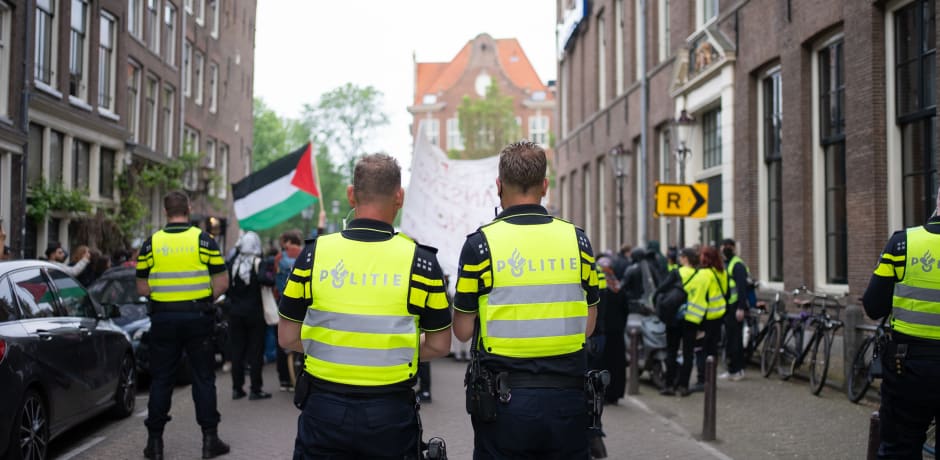
What are the limits of police brutality?
After last week’s evictions, protesters complained about “shocking” police brutality. What exactly are police allowed to do or not do? “An officer may sometimes use severe force when threatened,” argues UvA lecturer and former judge Richard Gerding.
Videos of cops kicking students lying down, seemingly blindly striking tents, and the large-scale deployment of bulldozers, police dogs, and batons. Many students complained about police brutality during the pro-Palestine demonstrations. The protest organization Amsterdam Encampment even set up an archive of “evidence of police brutality.”
Although such videos can be used as evidence in a criminal case, it is difficult to judge the violence in them without knowing the context, argues criminal law professor Richard Gerding. “Videos never present a total picture.”
Police brutality is tested against two principles, subsidiarity and proportionality, according to the Official Instruction, the legal framework for the use of force. “Subsidiarity means that you always have to see if a less severe means can be used. Proportionality looks at the fact that if you use force, you do so in proportion to the seriousness of the situation,” Gerding explains.
For example, during an eviction, police officers may be allowed only very limited use of force according to their orders. If during that action, however, these officers are threatened by protesters, according to proportionality, they could be ordered by their commander to deploy their batons and strike protesters.
Responsibility
On Wednesday, May 8th, during the occupation of the Binnengasthuisterrein, police loudspeakers called for the area to be cleared “by order of the mayor.” The mayor is responsible for maintaining public order and that, according to Gerding, “can be interpreted broadly.” The UvA professor explains: “The responsibility for which scenario of force deployment was used thus lies with the mayor. The latter is accountable to the city council.”

How violence is subsequently applied and whether it is proportionate is the responsibility of the police commander leading the eviction. If, as protesters claimed, the baton, bulldozers, tear gas or even more violent means were used unlawfully, the police commander is not criminally liable as long as he acts in accordance with the mayor's instructions.
“The individual officer is only criminally liable if he has not acted in accordance with his instructions,” explains Gerding. When police officers act in groups, they follow orders from their commander, who is then responsible. “Officers have earpieces for a reason, allowing them to hear instructions continuously.”
Persecuting police officers
Yet that can also go wrong. This was experienced, for example, by 16-year-old farmer Jouke, whose tractor was shot at by an agent acting independently during the farmers’ protests. The policeman was sentenced to suspended imprisonment because it did not appear that the tractor had hit him. Thus, according to the judge, he should not have used the violent means of violence, his service weapon.
“The use of force must therefore be in proportion to the violent situation in which the officer finds himself,” Gerding said. A police officer who saw someone coming at him with an iron pole during the 2021 corona riots on Coolsingel in Rotterdam was justified in shooting the man in the knee, according to the judge.
That you would not be allowed to hit with the baton overhead in the event of such a threat or an eviction, as some protesters argue, is nonsense, Gerding argues. “I wonder how else you would be allowed to hit with it. It is, however, normally not allowed to hit protesters’ heads.”
Peaceful
In an eviction, such as those at Roeterseiland and the Binnengasthuisterrein, the mayor determines how order will be restored, even if peaceful protesters are present. Gerding explains: “The police commander on site then determines how exactly that should be done. And it is then especially important that the group disrupting public order is warned of the violence that will be used.” With that, even peaceful protesters can then expect a violent eviction.
“Before the police proceed to use their batons, a loud and clear warning must be given,” Gerding said. During the evacuation of the Binnengasthuis occupation, however, that one-time warning, broadcast over loudspeakers, was barely audible to protesters and bystanders because of the slogans being chanted. But, says Gerding, it is enough that the police make it clearly known. “Speakers can only be so loud, too, and eventually it stops.”
Report
Whether the violence in the UvA evictions was applied proportionately, Gerding cannot and will not judge. However, there should be a difference in the violence at different types of demonstrations. “For example, I can imagine, so to speak, that at the Extinction Rebellion highway protests a police van would not be driven into demonstrators.”
Before an actual investigation by the prosecutor’s office or prosecution is possible, charges must first be filed. Anyone who has “taken cognizance of the fact” may file a report about that particular case, Gerding said. Mayor Halsema has also called on victims of police violence in recent weeks to report the crime. A single ME officer who kicked a protester multiple times last Monday has already reported himself. The Amsterdam Police Department states that it has received official complaints from several people, but has not yet received any reports.

